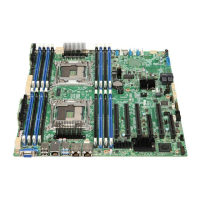Intel® Server Board S2600CW Functional Architecture Intel® Server Board S2600CW Family TPS
30 Revision 2.4
Memory Disable and Map out for FRB: Allows memory initialization and booting to the
OS even when memory fault occurs.
Data Scrambling with Command and Address: Scrambles the data with address and
command in "write cycle" and unscrambles the data in "read cycle". Addresses
reliability by improving signal integrity at the physical layer. Additionally, assists with
detection of an address bit error.
DDR4 Command/Address Parity Check and Retry: DDR4 technology based
CMD/ADDR parity check and retry with following attributes:
- CMD/ADDR Parity error “address” logging
- CMD/ADDR Retry
Intra-Socket Memory Mirroring: Memory Mirroring is a method of keeping a duplicate
(secondary or mirrored) copy of the contents of memory as a redundant backup for
use if the primary memory fails. The mirrored copy of the memory is stored in memory
of the same processor socket. Dynamic (without reboot) failover to the mirrored DIMMs
is transparent to the OS and applications. Note that with Memory Mirroring enabled,
only half of the memory capacity of both memory channels is available.
Memory Demand and Patrol Scrubbing: Demand scrubbing is the ability to write
corrected data back to the memory once a correctable error is detected on a read
transaction. Patrol scrubbing proactively searches the system memory, repairing
correctable errors. It prevents accumulation of single-bit errors.
HA and IMC Corrupt Data Containment: Corrupt Data Containment is a process of
signaling memory patrol scrub uncorrected data errors synchronous to the transaction
thus enhancing the containment of the fault and improving the reliability of the
system.
Rank Level / Multi Rank Level Memory Sparing: Dynamic failover of failing ranks to
spare ranks behind the same memory controller. With Multi Rank, up to four ranks out
of a maximum of eight ranks can be assigned as spare ranks. Memory mirroring is not
supported when memory sparing is enabled.
Failed DIMM Isolation: The ability to identify a specific failing DIMM, thereby enabling
the user to replace only the failed DIMM(s). In case of uncorrected error and lockstep
mode, only DIMM pair level isolation granularity is supported.
3.3.6 Memory Initialization
Memory Initialization at the beginning of POST includes multiple functions, including:
DIMM discovery
Channel training
DIMM population validation check
Memory controller initialization and other hardware settings
Initialization of RAS configurations (as applicable)

